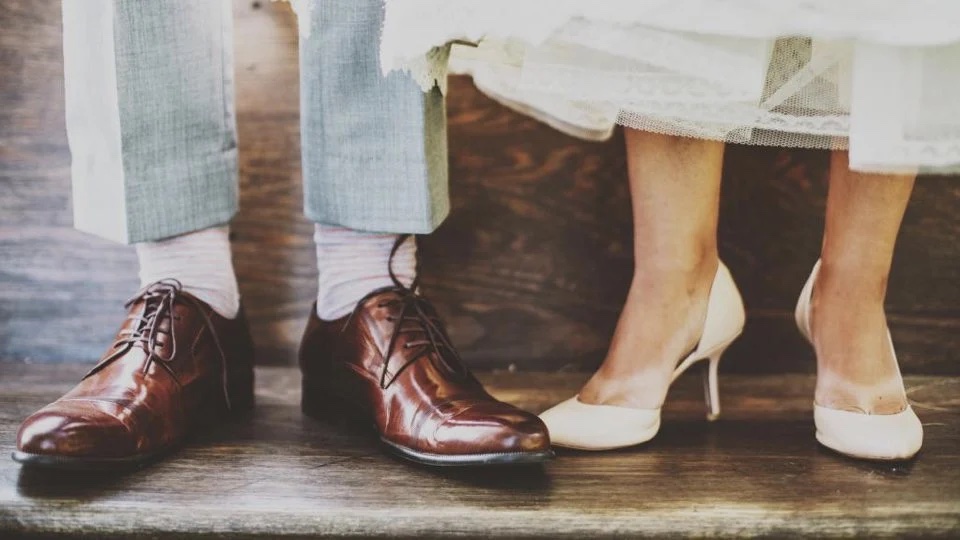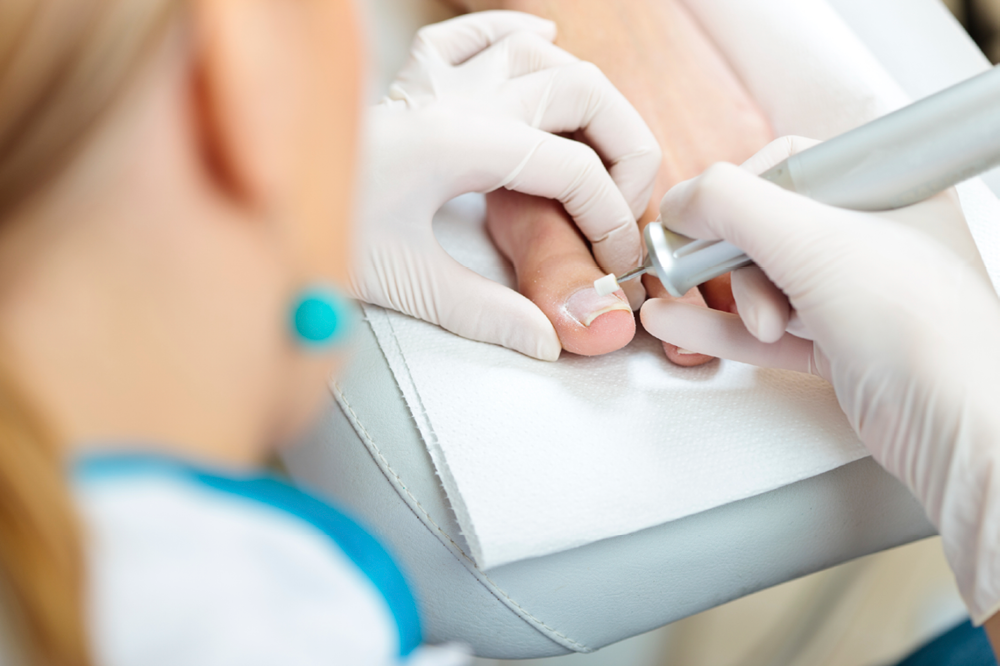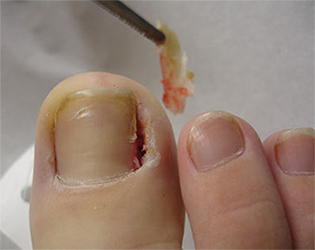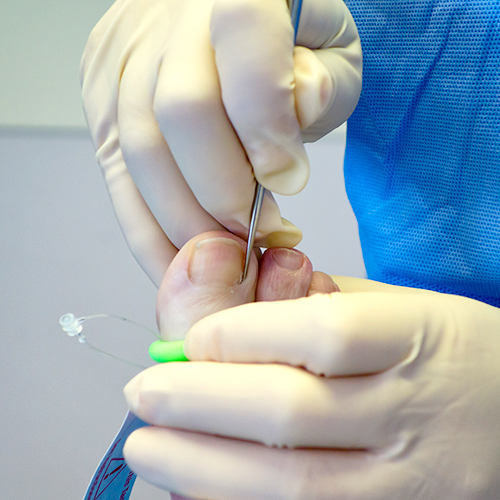Ingrown Toenail

What is an ingrown toenail?
An ingrown toenail is a toenail which has grown inwards into the skin, and often causes pain on the sides of the toe. This is commonly seen on the two big toes of each foot and may lead to infections which can leave the toe red, swollen, painful, and sometimes have pus coming out of it.
Ingrown toenails are very common, approximately 20% of people who visit their Doctor complain about ingrown toenails. In most occasions, these people are given antibiotics and asked to soak their feet in warm water with Epsom salts. However, the infection will persist if the offend nail is not removed.

WHAT CAUSES INGROWN TOENAILS?
- Poor toenail cutting technique – The nails should be cut straight across the top when cutting your nails at home. Cutting your nails too short, or cutting the sides of the toenails yourself can increase the risk of having ingrown toenails. This is because you may leave behind a spicule which can grown out into the skin and cause complications.
- Trauma to the toenail and surrounding skin – Pulling, ripping or cutting down the sides of the nail yourself increases the risk of getting ingrown toenails. It is best to have the ingrown toenail and surrounding skin by your Podiatrist to reduce the risk of complications in the future.
- Poorly fitted footwear – Wearing shoes that are too tight or that may not have enough room for your toes can lead to pressure on the skin surrounding the nail and cause them to curl inwards, and this can lead to ingrown toenails. Sometimes the curling of the toenail into the skin is permanent and cannot be fixed, unless you have surgery to remove that side of the nail permanently.

WHAT ARE THE RISK FACTORS FOR HAVING INGROWN TOENAILS?
- Genetics – As frustrating as it is, ingrown toenails can be genetic. Your mum, dad, uncle, aunty or even a second cousin may have ingrown toenails. You would of received the same genes that predisposes you to ingrown toenails.
- Adolescents – During this period of life, the feet tend to perspire more, meaning the nail and skin soften, which may lead to ingrown toenails.
- Reduced ability to care for nails – Not taking care of your nails, or trying to take care of them when you physically cannot reach them can cause trauma and increase the risk of having ingrown toenails.
- Poor nail habits – Cutting the nails too short or trying to round the corners can encourage the nails to grown into the skin.
- Sports – Participating in activities that involve running or kicking, such as soccer, can increase the risk of trauma and injury to your toes. This leads to ingrown toenails.
- Health Conditions – Conditions that poor blood flow, such as Diabetes can increase the risk of ingrown toenails.

HOW CAN I PREVENT INGROWN TOENAILS AT HOME?
To help prevent the risk of ingrown toenails:
- Correct cutting technique – Ensure you only cut your nails across the top. Any removal of an ingrown toenail should be removed by your Podiatrist.
- Maintain moderate length nails – Ensure you maintain a healthy length of nail by NOTcutting your toenails too short. If the nails are cut too short, pressure from your shoes can encourage the nails to grown into the skin around the nail.
- Wearing proper fitted footwear – Ensure your shoes are the right size and not too small. It is also important that you DO NOT wear shoes that are too tight or are ‘pointy’ from the front. If you have nerve damage (neuropathy) in the feet, you may not be able to feel wether your shoes are too small or tight.
- Wearing protective footwear – If you engage in activity that increases your risk of injury or trauma to your toes, you will need to wear protective (steel-cap) boots or shoes to protect your feet from injury.
- Check your feet regularly – It is important to check your feet daily for any signs of ingrown toenails or other foot problems (red, hot, swollen, pus, pain).
- Seeing a Podiatrist – If you are unable to do your own toenails due to health complications or age, you may be eligible for a GP Care Plan which means you will be eligible for up to 5 medicare rebated visits per year. At the Foot Force Podiatry, we bulk-bill general treatments to maintain your skin and nail care. All you need to do is see your GP and ask wether you are eligible.

WHAT TREATMENT IS AVAILABLE FOR INGROWN TOENAILS?
When seeing a Podiatrist for ingrown toenails, your treatment is dependant on the severity, wether you have risk factors and/or the reason(s) that you get them. If this is the first time you experience an ingrown toenail and you think it may be caused from wearing tight shoes, conservative treatment will suffice.
Conservative treatment consists of a general treatment where the offending nail edge will be removed. In cases where the ingrown toenail is very painful, local anaesthetic can be given to numb the toe for a painless experience. This will give an opportunity for the toe and skin around the nail to heal. It will also reduce a lot of the pressure and reduce the pain dramatically.
In cases where the ingrown toenail is always coming back, and is causing issues on a regular basis, it is more appropriate to have nail surgery to remove the ingrown toenail long-term. At our clinic, we have seen up to 99% success rate with ingrown toenail surgery.

What is ingrown toenail surgery?
Ingrown toenail surgery, also known as a partial nail avulsion (PNA) is a surgery which provides a permanent solution to your ingrown toenail. It is commonly done on the big toes, but can also be done on the little toes. Usually, only a small portion of the nail needs to be removed, not the whole nail.
The Podiatrist will first numb the toe with an injection to ensure the surgery is pain free. A tourniquet is applies around the toe (see the green band around the big toe on the image on the right) to stop any bleeding. The Podiatrist will then seperate the nail from the skin and remove only the part of the nail that is causing problems. Once that part of the nail, the nail root and any dead skin is removed, the Podiatrist will use a chemical called phenol to kill the nail root inside the toe to make sure that side of the nail does not grow back anymore. Your toe will be bandaged and some home care instructions will be given to you. You will need to come back to see your Podiatrist in 2-3 days for a check up and redress.
If you feel like you would benefit from the surgery, please book in for a ‘pre-surgery consultation and assessment for ingrown toenails’ with our expert Podiatrist.
Dr. Fatima Al-Kathmi (Podiatrist)
The Foot Force Podiatry.
BOOK NOWContact Us
Send us an e-mail:
This site is protected by reCAPTCHA and the Google Privacy Policy and Terms of Service apply.
